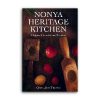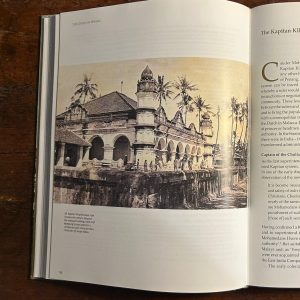Nonya Heritage Kitchen: Origins, Utensils and Recipes brings together the stories of how popular food, cooking techniques, ingredients and utensils from these spheres of influence interacted to create Nonya cuisine … an extraordinary and practical cookbook that reveals new information about the wide-spread and global roots of Nonya food.
The Peranakan or Baba and Nonya culture is the result of intermarriage, from the 15th century, between Chinese immigrants and the local population of Indonesia and Malaya. Thus, Nonya cuisine is an early example of fusion food, one that evolved from this integration of Malay and Hokkien food with the colonial cuisines of Portugal, the Netherlands and England.
Malay dishes are characterized by the use of coconut milk, sour tamarind, piquant shallots and garlic, aromatic lemongrass, and fragrant gingers like turmeric, galangal and lesser galangal. Root vegetables like tapioca, sweet potato and yam are also commonly used.The many leaves and shoots used for flavouring in the Malay kitchen include kaffir lime leaves, a variety of wild pepper leaf known as daun leadole, pandan and Polygonum. ]ade-green pandan is also used for colouring, as are bunga telang – the blue Butterfly Pea flower, and bright orange turmeric. Belacan, the pungent dried shrimp paste, is another very important Malay ingredient. Chillies, so essential to Malay cuisine, were introduced to the region by Portuguese colonizers. Nonya dishes like Roti ]ala, Acar Awak, and Sesargon are predominantly Malay, their key ingredients being spices and coconut that are common in every kampong.
The food products from Fujian province shaped Hokkien cuisine: Seafood from the coastal waters, and bamboo shoots, fungi, fruits and nuts from the mountainous forests. So, Hokkien influence in Nonya cuisine can be clearly seen in the use of ingredients like crab, pickled vegetable, bamboo shoots and beans.These are the main ingredients of classic Nonya dishes like Bak Wan Kepiting, Kiam Chai Ark, Koay Pai Ti and Ang Koo Kuih.
A large number of recipes in this book are for snacks prepared for festive occasions celebrated by the Chinese, Malays and Peranakans. Most of these Nonya kuihs have either Malay or Hokkien origins, and it is no coincidence that the words in Hokkien, Malay and Indonesian for them are koay, kuih and kue.
For further reading, please read our newsletters.









